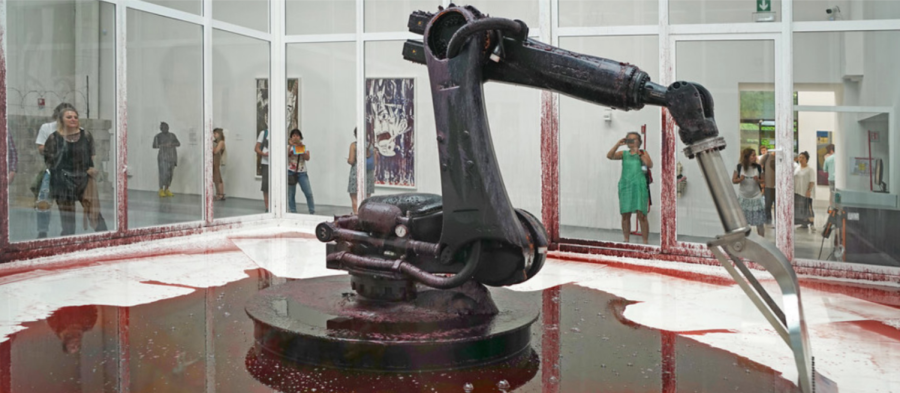Mechanical museum exhibit touches “bleeding arts”
CREATIVE COMMONS PHOTO BY JEAN-PIERRE DALBERA
The display “Can’t Help Myself” by Sun Yuan and Peng Yu attracts many visitors. Photo licensed under CC BY 2.0. https://creativecommons.org/ licenses/by/2.0/?ref=openverse&atype=rich
January 28, 2022
TikTok: an app of exploration, discovery and extreme creativity that breaks the boundaries of art as we know them.
With the emergence of the COVID-19 pandemic and creative quarantine hobbies, two activities have become more common: studying art and scrolling through TikTok.
Within the app, assorted artwork has emerged and gained popularity, including paintings, sculptures, murals and even simple sketches.
Two pieces that TikTok users have come to appreciate are “Can’t Help Myself” and “Untitled (Portrait of Ross in L.A.).”
According to the Guggenheim Museum, “Can’t Help Myself” was created by Sun Yuan and Peng Yu in 2016 for the Guggenheim Museum in New York City. The piece features a robotic arm that is constantly twisting in a circular motion. Surrounding this object is a deep red, hydraulic fluid, which the robot arm is attempting to clean up by dragging the liquid closer to the center.
Per the website, this art exhibit uses “visual-recognition sensors and software systems to examine our increasingly automated global reality, one in which territories are controlled mechanically and the relationship between people and machines is rapidly changing.”
Over the past year, multiple TikToks were posted about this exhibit with users explaining how it makes people feel or how it relates to the current global climate.
Sophomore Jordan Juliano of Long Branch, a regular TikTok user, has seen this exhibit through recommended videos.
“When I saw the exhibit, I was really sad because I just felt the machine was really helpless,” Juliano said. “Even though the robot had no emotions, I could understand it felt trapped.”
While Juliano said he is not the most artistic, he was still able to appreciate the message and uniqueness presented by the exhibit.
“Untitled (Portrait of Ross in L.A.),” created by Felix Gonzalez-Torres, is a conceptual art piece found in the Art Institute of Chicago in Illinois.
This piece ideally features 175 pounds of candy, representing the ideal body weight of Gonzalez-Torres’s late partner, Ross, who died of an AIDS-related illness. The candy, however, does not last as viewers are encouraged to take a piece each time they visit, intended to represent the pain of watching a loved one deteriorate, as well as suggesting the possibility of an eternal life for Ross.
Similarly to “Can’t Help Myself,” this art piece has gone viral on TikTok multiple times in the past few months with many users leaving comments contemplating the real meaning behind the piece.
Laura Fallon, a design teacher at Communications High School, was recently introduced to both of these art pieces.
“While I’m not on TikTok and was not familiar with either piece that has gone viral, I do kind of love that art, especially installation art, is being shared and discussed on the platform,” Fallon said.
Among these discussions, people have begun to wonder why interpretive art has been picked up by the masses. Although there is no single explanation, after two years of limited interactions with others and an abundance of loss, it is no coincidence that we may be looking for answers in the form of art.
Fallon praised the discussions, saying “I think conceptual art is meant to be experienced and interacted with and in this case, views on TikTok are doing just that.”





